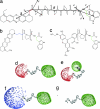Probing polyproline structure and dynamics by photoinduced electron transfer provides evidence for deviations from a regular polyproline type II helix
- PMID: 17956989
- PMCID: PMC2077268
- DOI: 10.1073/pnas.0705605104
Probing polyproline structure and dynamics by photoinduced electron transfer provides evidence for deviations from a regular polyproline type II helix
Abstract
Polyprolines are well known for adopting a regular polyproline type II helix in aqueous solution, rendering them a popular standard as molecular ruler in structural molecular biology. However, single-molecule spectroscopy studies based on Förster resonance energy transfer (FRET) have revealed deviations of experimentally observed end-to-end distances of polyprolines from theoretical predictions, and it was proposed that the discrepancy resulted from dynamic flexibility of the polyproline helix. Here, we probe end-to-end distances and conformational dynamics of poly-l-prolines with 1-10 residues using fluorescence quenching by photoinduced-electron transfer (PET). A single fluorophore and a tryptophan residue, introduced at the termini of polyproline peptides, serve as sensitive probes for distance changes on the subnanometer length scale. Using a combination of ensemble fluorescence and fluorescence correlation spectroscopy, we demonstrate that polyproline samples exhibit static structural heterogeneity with subpopulations of distinct end-to-end distances that do not interconvert on time scales from nano- to milliseconds. By observing prolyl isomerization through changes in PET quenching interactions, we provide experimental evidence that the observed heterogeneity can be explained by interspersed cis isomers. Computer simulations elucidate the influence of trans/cis isomerization on polyproline structures in terms of end-to-end distance and provide a structural justification for the experimentally observed effects. Our results demonstrate that structural heterogeneity inherent in polyprolines, which to date are commonly applied as a molecular ruler, disqualifies them as appropriate tool for an accurate determination of absolute distances at a molecular scale.
Conflict of interest statement
The authors declare no conflict of interest.
Figures




Similar articles
-
Structural heterogeneity and quantitative FRET efficiency distributions of polyprolines through a hybrid atomistic simulation and Monte Carlo approach.PLoS One. 2011;6(5):e19791. doi: 10.1371/journal.pone.0019791. Epub 2011 May 24. PLoS One. 2011. PMID: 21629703 Free PMC article.
-
Intramolecular distances and dynamics from the combined photon statistics of single-molecule FRET and photoinduced electron transfer.J Phys Chem B. 2013 Oct 24;117(42):13015-28. doi: 10.1021/jp402352s. Epub 2013 May 29. J Phys Chem B. 2013. PMID: 23718771
-
Polyproline and the "spectroscopic ruler" revisited with single-molecule fluorescence.Proc Natl Acad Sci U S A. 2005 Feb 22;102(8):2754-9. doi: 10.1073/pnas.0408164102. Epub 2005 Feb 7. Proc Natl Acad Sci U S A. 2005. PMID: 15699337 Free PMC article.
-
Fluorescence resonance energy transfer (FRET) and competing processes in donor-acceptor substituted DNA strands: a comparative study of ensemble and single-molecule data.J Biotechnol. 2002 Jan;82(3):211-31. doi: 10.1016/s1389-0352(01)00039-3. J Biotechnol. 2002. PMID: 11999691 Review.
-
Fluorescence quenching by photoinduced electron transfer: a reporter for conformational dynamics of macromolecules.Chemphyschem. 2009 Jul 13;10(9-10):1389-98. doi: 10.1002/cphc.200900238. Chemphyschem. 2009. PMID: 19475638 Review.
Cited by
-
Ratiometric Molecular Probes Based on Dual Emission of a Blue Fluorescent Coumarin and a Red Phosphorescent Cationic Iridium(III) Complex for Intracellular Oxygen Sensing.Sensors (Basel). 2015 Jun 9;15(6):13503-21. doi: 10.3390/s150613503. Sensors (Basel). 2015. PMID: 26066988 Free PMC article.
-
The Effect of dye-dye interactions on the spatial resolution of single-molecule FRET measurements in nucleic acids.Biophys J. 2010 May 19;98(10):2265-72. doi: 10.1016/j.bpj.2010.02.008. Biophys J. 2010. PMID: 20483335 Free PMC article.
-
Protein folding at single-molecule resolution.Biochim Biophys Acta. 2011 Aug;1814(8):1021-9. doi: 10.1016/j.bbapap.2011.01.011. Epub 2011 Feb 17. Biochim Biophys Acta. 2011. PMID: 21303706 Free PMC article. Review.
-
Structural distributions from single-molecule measurements as a tool for molecular mechanics.Chem Phys. 2012 Mar 2;396:61-71. doi: 10.1016/j.chemphys.2011.06.014. Epub 2011 Jun 22. Chem Phys. 2012. PMID: 22661822 Free PMC article.
-
Structural heterogeneity and quantitative FRET efficiency distributions of polyprolines through a hybrid atomistic simulation and Monte Carlo approach.PLoS One. 2011;6(5):e19791. doi: 10.1371/journal.pone.0019791. Epub 2011 May 24. PLoS One. 2011. PMID: 21629703 Free PMC article.
References
Publication types
MeSH terms
Substances
LinkOut - more resources
Full Text Sources

